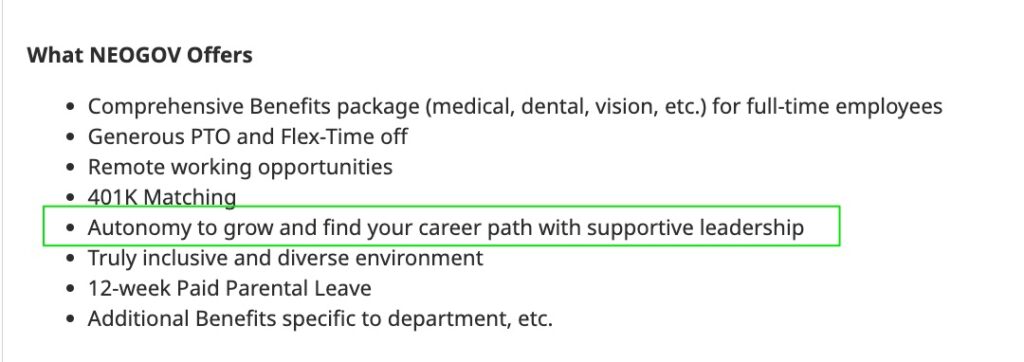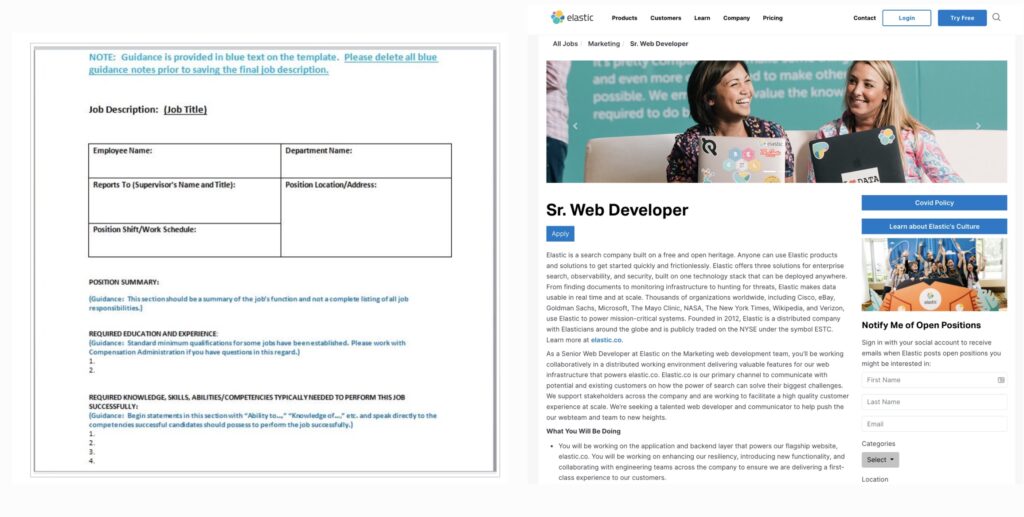- 15 Benefits of AI in Recruitment/Talent Acquisition - December 19, 2025
- Is Performative Inclusion Hurting Your Talent Pipeline? - December 9, 2025
- Is The Lack of Career Growth Losing You Valuable Hires? - November 20, 2025

The importance of job descriptions for employers is vital to the hiring process. JDs show your unique culture and set employee expectations. To create quality JDs, you’ll need to do more than list the basic tasks, requirements, and skills for a position.
For instance, your JDs should include your company’s core values and social responsibilities. It’s what job seekers can expect from joining your company when they apply.
Here are 7 reasons why JDs matter:
1. Job descriptions help you find top talent
Crafting easy-to-read JDs attracts top talent.
A good JD should be clear and concise, highlight important information like duties and requirements, and outline career goals and core competencies.
Doing this puts all expectations on the table. There is nothing left to guesswork. Applicants know what they sign up for, and you’ll consistently get quality applicants.
You can break most jobs down into 6-7 performance-based criteria. Consider identifying the criteria by reviewing the performance of employees who held the role in the past.
For example, if you’re seeking someone with attention to detail. Be specific about how it relates to the role and your organization. You might want to finetune the search for someone who can “manage flawless audits for your department.”
2. Unique job descriptions are “attention-grabbers”
Polished JDs work wonders by connecting with talent at a glance. A JD with specialized skills speaks directly to targeted candidate groups.
Avoid buzzwords, jargon, or any language that makes the JD harder to read. A unique, quality JD guides job seekers to your company with the right keywords without confusing them (and keeping their attention longer).
Pro-tip, you can find the most popular keywords by looking at the latest JDs of top competitors. Once you have gathered these insights, you can create a search-optimized JD that job seekers will easily find online.
A simple and keyword-driven job description makes it more searchable. Lacking the right keywords might cause the most compelling JDs to be “unsearchable.”
3. Job descriptions encourage career advancements
Great JDs outline career pathways to help employees make the best decisions for progressing in their careers. If job seekers don’t have certain skills, they can learn them along the way, adding value to your company.
Interested job seekers can also align their career goals based on your company’s values to accelerate performance and future promotions.
Outlining career pathways helps candidates assess the work environment and any potential stressors. Assessing these factors helps applicants decide if your company offers an ideal environment for long-term growth.
Even if you list a generic statement in support of career growth, your JDs will stand out compared to others. Here’s one example:

4. Job descriptions set the stage for work-life balance
A detailed JD clarifies job responsibilities. Hires can refer to their JDs to understand their roles and duties. As such, employees can avoid distractions outside of their core duties. JDs can help you create a transparent work culture that minimizes the risks of stress, burnout, and turnovers.
If your company is built on a foundation of work-life balance, be sure to mention this in your JDs. For example, offering hybrid or remote working options is a huge selling point for talent:
“32% of working professionals would consider relocating with a pay cut, if given the opportunity to work from home as much as they would like.”
source: Team Blind Survey of 2,861 users
5. Job descriptions set the stage for performance and training benchmarks
You can review an employee’s performance with a JD by checking role requirements. Your JD should include criteria like industry certifications, qualifications, and licenses needed if they are key to performing a role. These search factors can help you decide if hires need future training or reskilling.
A solid job description helps hiring managers with performance appraisals. And, JDs function as a reliable checklist for identifying employee strengths. JDs make it easier to highlight competencies for further improvement. By doing so, your team can provide relevant training according to individual employee profiles.
If you list salary, and we think you should, JDs also help with future pay raises and promotions (with fairer practices and transparency).
If your company uses internal job descriptions to help build out external job postings, you may not carry over all of the content, but the internal JDs are a great place to start when crafting postings.
Here’s a side-by-side comparison of a job description vs job posting from Elastic that shows the differences you might find between the 2:

6. Job descriptions start interactive DEIB dialogues
Job descriptions prevent unconscious biases in hiring and support diversity, equity, inclusion, and belonging initiatives. DEIB initiatives are crucial for inclusive culture at work. A solid DEI culture makes roles more accessible to everyone. Also, your JDs can help start interactive discussions like meeting the accommodations under the Americans with Disabilities Act.
For example, referencing employee resource groups (ERGs) helps break social barriers from the start. Or listing your commitment to DEIB or a statement about your company’s stance on culture will make people from underrepresented groups feel more comfortable applying for a position.
here’s an example of one of these statements from East Bank Club:
“Diversity, Inclusion, and Belonging Matters:
East Bank Club commits to a culture of inclusion and belonging characterized by connection across our similarities and differences. We honor the dignity of all employees by enabling each to reach their fullest potential and, by doing so, better serve our members. We serve a diverse group of members and recognize the importance of diversity and inclusion in enriching the employee and member experience required to support our mission. EBC is committed to attracting, retaining, and developing employees with varying identities and backgrounds.”
7. Job descriptions help resolve employment disputes
JDs are a good reference item during legal disputes with employee terminations. For instance, your JD details can justify poor performance reviews. Specifically, you can note ineffective performance due to a poor job fit.
JDs also help you solve employee disagreements without bias. Some potential scenarios include task conflicts, resource management issues, and misinterpreted policies.
Effective JDs also help hires perform better in their roles with proper guidance. These role descriptions can create a sense of purpose and improve overall job satisfaction.
The Importance of Job Descriptions in the Modern Workplace
JDs aren’t just simple role descriptions. A quality JD shares job expectations and improves company onboarding. And the hiring landscape has changed post-COVID. Plus, more Gen Z’ers are looking for roles.
The latest Appcast research shows JDs without gender bias are proven to increase apply rates and lower your cost per application. And, you’ll also attract candidates from other underrepresented groups.
Well-written JDs remove unconscious biases. These biases compromise your hiring practices, often without realizing it. Also, your JDs should clearly communicate your values, mission, salary, and benefits. These are all things candidates care about in the modern workplace.
Why I Wrote This:
Ongig’s mission is all about supporting the importance of job descriptions to help you attract top talent. Please request a demo to learn more about setting your focus on creating effective and inclusive JDs, so you’ll wow candidates every time.
Shout-Outs:
- Tim Madden, Forbes – What The Job Seekers Market Shift Means For Your Career
- Comparably – The Importance of Inclusive Job Descriptions to an Inclusive Workplace
- Isaiah Atkins, Business News Daily – Setting Clear Expectations for Employees
- Comparably – How to Tell if a Company Values Diversity
- US Department of Labor – Wages and the Fair Labor Standards Act
- Katie Shonk, Program of Negotiation Harvard Law School – 3 Types of Conflict and How to Address Them
- The Impact of Gendered Wording on Candidate Attraction – Appcast
